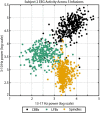Diversity of electroencephalographic patterns during propofol-induced burst suppression
- PMID: 37397237
- PMCID: PMC10309040
- DOI: 10.3389/fnsys.2023.1172856
Diversity of electroencephalographic patterns during propofol-induced burst suppression
Abstract
Burst suppression is a brain state consisting of high-amplitude electrical activity alternating with periods of quieter suppression that can be brought about by disease or by certain anesthetics. Although burst suppression has been studied for decades, few studies have investigated the diverse manifestations of this state within and between human subjects. As part of a clinical trial examining the antidepressant effects of propofol, we gathered burst suppression electroencephalographic (EEG) data from 114 propofol infusions across 21 human subjects with treatment-resistant depression. This data was examined with the objective of describing and quantifying electrical signal diversity. We observed three types of EEG burst activity: canonical broadband bursts (as frequently described in the literature), spindles (narrow-band oscillations reminiscent of sleep spindles), and a new feature that we call low-frequency bursts (LFBs), which are brief deflections of mainly sub-3-Hz power. These three features were distinct in both the time and frequency domains and their occurrence differed significantly across subjects, with some subjects showing many LFBs or spindles and others showing very few. Spectral-power makeup of each feature was also significantly different across subjects. In a subset of nine participants with high-density EEG recordings, we noted that each feature had a unique spatial pattern of amplitude and polarity when measured across the scalp. Finally, we observed that the Bispectral Index Monitor, a commonly used clinical EEG monitor, does not account for the diversity of EEG features when processing the burst suppression state. Overall, this study describes and quantifies variation in the burst suppression EEG state across subjects and repeated infusions of propofol. These findings have implications for the understanding of brain activity under anesthesia and for individualized dosing of anesthetic drugs.
Keywords: anesthesia; burst suppression; depression; electroencephalograph (EEG); propofol.
Copyright © 2023 Jones, Lybbert, Euler, Huang, Lunt, Richards, Jessop, Larson, Odell, Kuck, Tadler and Mickey.
Conflict of interest statement
The authors declare that the research was conducted in the absence of any commercial or financial relationships that could be construed as a potential conflict of interest.
Figures






Similar articles
-
Age-Related EEG Features of Bursting Activity During Anesthetic-Induced Burst Suppression.Front Syst Neurosci. 2020 Dec 3;14:599962. doi: 10.3389/fnsys.2020.599962. eCollection 2020. Front Syst Neurosci. 2020. PMID: 33343307 Free PMC article.
-
Evoked EEG patterns during burst suppression with propofol.Br J Anaesth. 2004 Jan;92(1):18-24. doi: 10.1093/bja/aeh022. Br J Anaesth. 2004. PMID: 14665548
-
Substance-Specific Differences in Human Electroencephalographic Burst Suppression Patterns.Front Hum Neurosci. 2018 Sep 21;12:368. doi: 10.3389/fnhum.2018.00368. eCollection 2018. Front Hum Neurosci. 2018. PMID: 30297992 Free PMC article.
-
Burst Suppression During General Anesthesia and Postoperative Outcomes: Mini Review.Front Syst Neurosci. 2022 Jan 7;15:767489. doi: 10.3389/fnsys.2021.767489. eCollection 2021. Front Syst Neurosci. 2022. PMID: 35069132 Free PMC article. Review.
-
[Mechanism of anesthesia: view from the EEG during anesthesia].Masui. 2011 May;60(5):559-65. Masui. 2011. PMID: 21626859 Review. Japanese.
Cited by
-
GABAergic Neurons in the Central Amygdala Promote Emergence from Isoflurane Anesthesia in Mice.Anesthesiology. 2025 Feb 1;142(2):278-297. doi: 10.1097/ALN.0000000000005279. Epub 2024 Oct 28. Anesthesiology. 2025. PMID: 39466630 Free PMC article.
-
Clinical characteristics of 27 children with febrile infection-related epilepsy syndrome in a single center.Pediatr Discov. 2024 Jun 9;2(2):e84. doi: 10.1002/pdi3.84. eCollection 2024 Jun. Pediatr Discov. 2024. PMID: 40625895 Free PMC article.
-
Propofol enhancement of slow wave sleep to target the nexus of geriatric depression and cognitive dysfunction: protocol for a phase I open label trial.BMJ Open. 2024 May 30;14(5):e087516. doi: 10.1136/bmjopen-2024-087516. BMJ Open. 2024. PMID: 38816055 Free PMC article.
References
-
- Andresen J. M., Girard T. D., Pandharipande P. P., Davidson M. A., Ely E. W., Watson P. L. (2014). Burst suppression on processed electroencephalography as a predictor of postcoma delirium in mechanically ventilated ICU patients. Crit. Care Med. 42 2244–2251. 10.1097/ccm.0000000000000522 - DOI - PMC - PubMed
LinkOut - more resources
Full Text Sources
Research Materials
Miscellaneous

